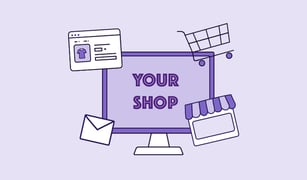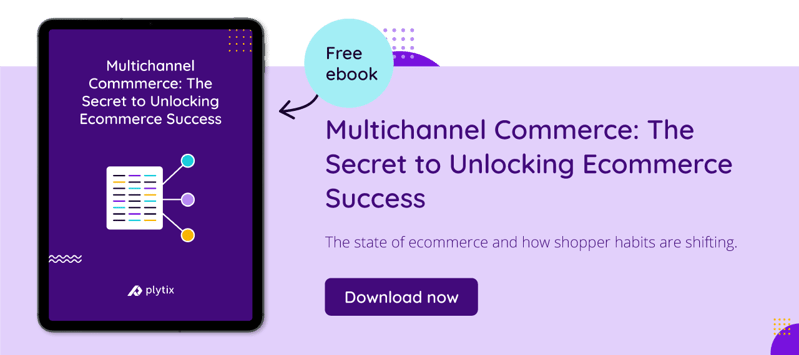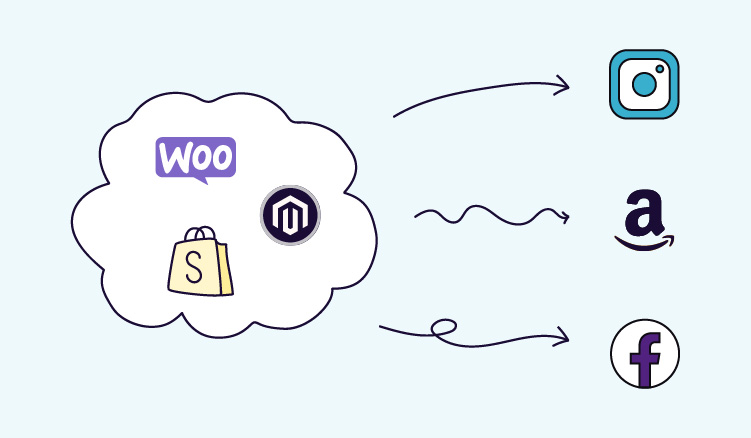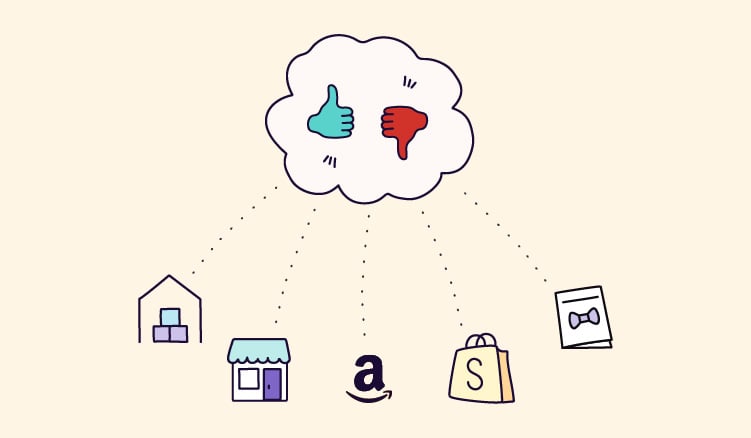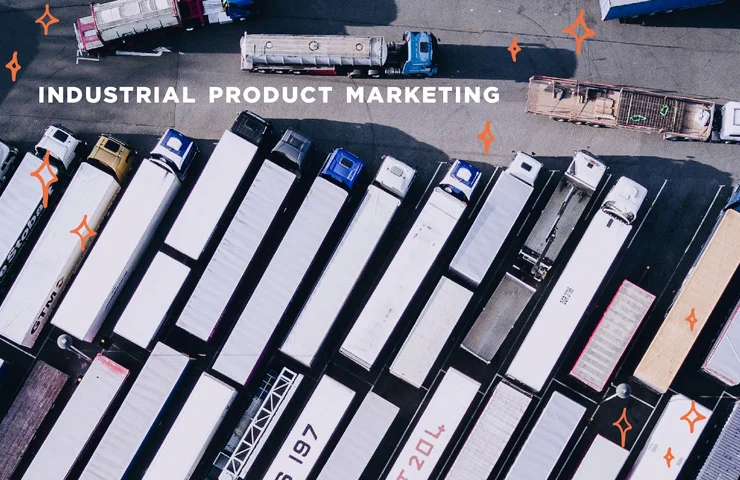Ready for some shocking information? It turns out that if you're selling products online, it’s pretty important to promote them, whether it’s through marketing channels, social media, third-party marketplaces, or wherever else. After all, to quote Michael Scott quoting Wayne Gretsky, “You miss 100% of the shots you don’t take.”
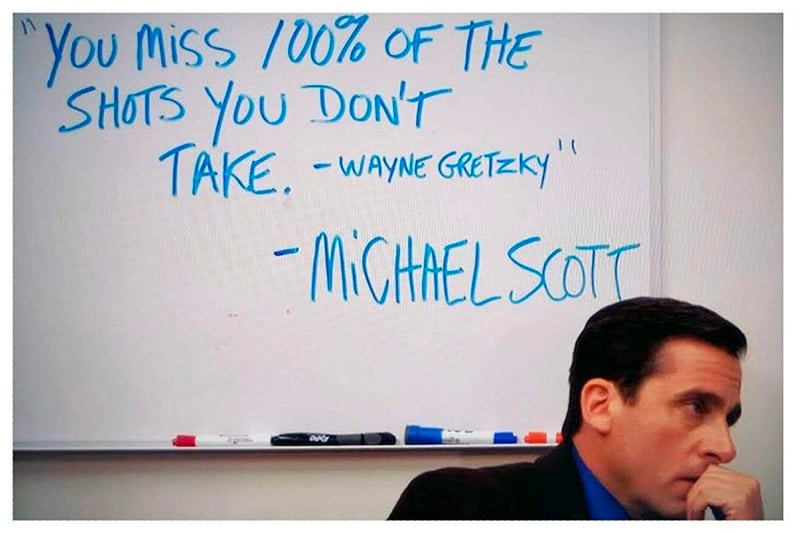
One of the great minds of our time. (Source)
Now for shocking fact #2: It turns out the more places you advertise and/or sell your products, the more customers end up engaging with your brand and ultimately buying your products—crazy, I know. Just check out these statistics:
- Businesses using 2 or more channels in one campaign experienced 166% higher engagement rates.
- Businesses adopting a multichannel marketing strategy experience a 91% higher yearly customer retention rate.
- 73% of consumers say they use multiple channels during their shopping journey.
- Retailers who sell on multiple channels generate 190% more revenue than retailers who stick to just one platform.
Which methods, platforms, and channels are right for you though? It’s all too easy to go for the same big names and typical techniques as everyone else, but that means you’re competing with, well, everyone else. What about taking the less-beaten path and going for a non-traditional choice? With that in mind, here are some product promotion opportunities that perhaps you’ve overlooked.
Think global: Exploring international marketplaces
These days, if you’re not promoting your products to potential customers overseas, you’re leaving a massive amount of money on the table. Just look at the figures: In 2021, the total value of global B2C cross-border ecommerce was roughly 785 billion U.S. dollars. By 2030, that same value is predicted to hit 7.9 trillion dollars—do you really want to miss out on your share?
Logically enough, the simplest way to market your products internationally is by selling them on international marketplaces that are already well established, but which ones? You might have heard of Mercado Libre already, who currently rule the Latin American market, but what about Allegro in Poland, or Veepee and Cdiscount in France? Alibaba is pretty well known in the Asian hemisphere, sure, but have you considered Shopee and Flipkart as well? These marketplaces are worth literally billions if not trillions of dollars, and could introduce your brand to countless new customers. Time to start thinking outside the box across the borders.
Unlocking social commerce
Let’s cross another border, but this time into the world of social media. In addition to publicizing your products through the traditional ads scattered among pictures of your friends’ breakfasts, your friends’ cats, and your friends’ cats’ breakfasts, there’s also social commerce to consider. This strategy just keeps growing and growing, with more and more people choosing to buy products directly on social media platforms.
For either tactic, though, we have the question of which social media platforms to focus on—let’s have a look at a couple you might think are past it, a couple you may not be considering yet, and then a whole area that may surprise you.
The old-timers: Facebook and Pinterest
Journalists have been predicting the demise of Facebook for years now, so is it still worth your time and attention? Short answer: Yes. The veteran quarterback of the Metaverse team seems determined to stay in play, with up to 1.2 billion shoppers buying something online through Facebook Marketplace in an average month. With more than 50% of the market share for social commerce space, reports of this platform’s death remain greatly exaggerated, and it’s still very much worth including in your multichannel commerce roster.
Similarly, you’d be forgiven for thinking that Pinterest is on the way out, as it’s long been overtaken by TikTok and others in terms of pure popularity. Surprisingly, though, its ecommerce aspect is still massively on the up—the number of Pinterest users interacting with shopping pins has increased 44%, and shoppers now spend twice as much money there each month as users of other social commerce platforms. Couple that with its shifting demographics, in the form of an increase in both male and Gen Z users of 40% year-on-year, and I’d stick a pin in any plans to abandon this market just yet.
The (relatively) newcomers: TikTok and Snapchat
So, moving from the old to the new: Let’s talk TikTok. Frequently dismissed as a frivolous time-wasting app by, well, my parents, TikTok is actually on the rise as an ecommerce platform. The hashtag #TikTokMadeMeBuyIt has now topped 50 billion views, and according to a recent study Gen Z consumers are more likely to start their product searches on TikTok than on Google. Considering the fact that more Gen Z consumers say they shop online every day than any other generation, TikTok could well be worth investigating for your brand, especially as it now has a built-in shopping function allowing users to buy products in the app directly.
TikTok talk, done—time for a SnapChat chat. While their filters have been popular for years now—for a while there I was starting to forget what some of my friends look like without dog ears and a giant tongue—it’s only recently that their potential for ecommerce has started to become apparent. SnapChatters can now use augmented reality technology (AR) for everything from trying on clothes and make-up to experiencing 360º product demos, and just like with TikTok, they can then buy the products in question through the app in a… snap (sorry, I’ll see myself out).
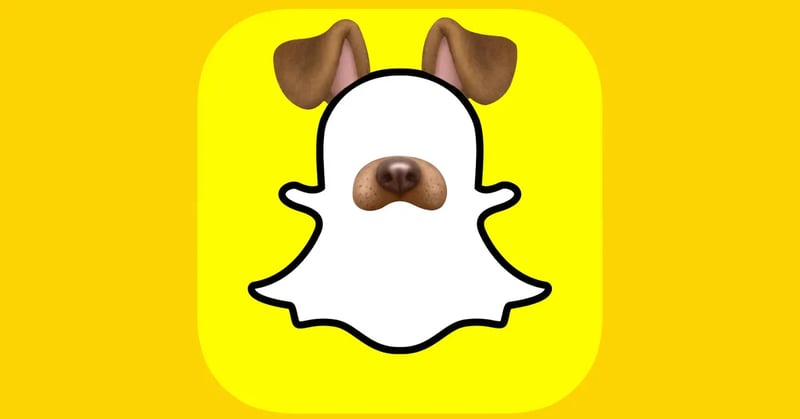
SnapChat: A retailer’s best friend? (Source)
The other fish in the social sea: Dating apps
Now, a less conventional way to put your products out there: dating apps. While most users aren’t generally on these apps to find furniture, fashion or fitness gear, the potential for creative product promotion and brand exposure is massive. Tinder, for example, has more than 75 million monthly users, and get this: More than 20% of them swipe right on brands.
That figure makes a lot more sense, though, if you consider just how much user data these apps have at their disposal. Think about the amount of personal information users readily provide in the hope of finding their perfect match—as a minimum, we’re talking age, gender, and relationship status, and as a maximum, we’re talking everything from jobs and salaries to travel plans, brand preferences, media consumption, hopes, and dreams for the future… you name it. In terms of raw data for targeted ads, what more could you ask for?
So, all in all, when it comes to using social media to promote your products, I’d give all these platforms a ✓ (as opposed to, oh, I don’t know, an X 🫢).
Promoting products through entertainment
Product promotion in an entertainment context is nothing new. After all, the first TV commercial aired more than 80 years ago (a ten-second ad for Bulova watches during a baseball game, if you were curious). Entertainment has come a long way since then though, so it makes sense that the way to sell people stuff while they’re being entertained has too—let’s have a look.
This time, we meme business (a.k.a. raising product awareness through memes)
In the era of viral content, meme pages are where the cool kids hang out (I’ve been told). These platforms offer a unique opportunity to engage with your audience while giving the impression that your brand is quirky and fun—kind of like Zooey Deschanel in business form. Consider partnering with popular meme accounts on Instagram or TikTok, or even submitting your own contributions to anywhere people can see them. Memes have an uncanny ability to spread like wildfire, and a cleverly crafted meme about your product can skyrocket your brand's visibility. Just ensure it's all in good fun and resonates with your target audience, and is funnier than my own effort down below.
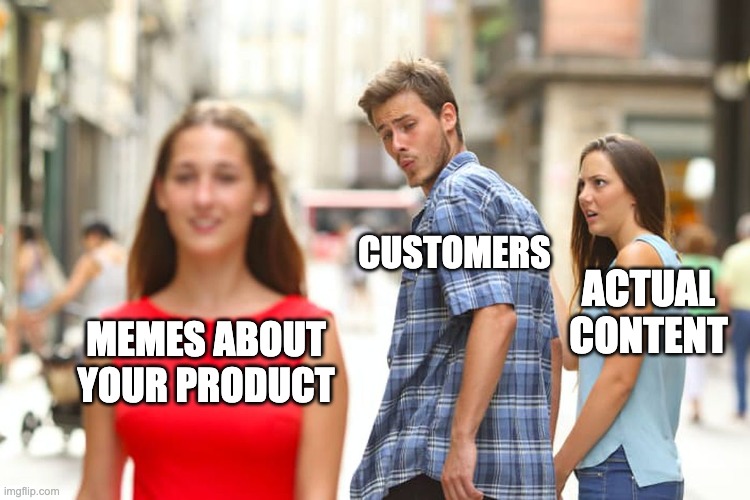
So meta, I know. (Source)
Marketing through podcasts and ASMR
Podcasts are the audio goldmines of the digital age. Millions of listeners tune in daily, making them an excellent platform for promoting your products. Consider sponsoring a podcast that aligns with your brand values and target audience—given how niche certain podcasts are, it’s a great way to reach very particular demographics. Hosts often weave ad placements seamlessly into their content without people even noticing (a tactic that simply ticks all the boxes, if you ask me), so it feels less like an ad and more like a recommendation from a trusted friend.
And then there's ASMR (Autonomous Sensory Meridian Response), the online phenomenon that's all about soothing sounds and sensations. If your product has a tactile or sensory component, ASMR could be your ticket to a unique marketing experience. Imagine the ASMR-worthy sounds of your product being unboxed, touched, or used, all while promoting its benefits. It's a sensory journey that can captivate and relax potential customers, even if all you’re doing is talking about how to manage ecommerce product data in a PIM system (to pick a totally random example).
Advertising in video games
Gaming isn't just for teenagers holed up in their rooms anymore; it's a massive industry that spans generations. Integrating your products into the gaming world can be a winning move, especially if your product or store becomes a functional part of the virtual landscape. Whether it's a covetable branded item included in an in-game loot box or a virtual store where players can buy real stuff that they can then use in real life, this immersive approach can quickly get you to the top of the sales league.

My personal game of choice. (Source)
Finding the right option(s) for you
In the ever-evolving environment of ecommerce, it's crucial to mix things up when it comes to promoting your products, and whatever happens, you’re much less likely to have success if customers can only see or buy your products in one place. Whether you're trying out global markets, diving into social media, or making waves in the entertainment scene, the more places you put your products, the better your sales will be, so don't be afraid to get a bit creative and promote your products in a variety of weird and wonderful places.
This strategy isn’t without its challenges though—it’s a lot of work to stay on top of multiple sales and marketing channels, and make sure all of your product information is in sync and showing up correctly across the web. As a result, a good multichannel strategy is going to be crucial for your future success, but don’t worry if you’re not sure how to put one together!. We’ve got you covered—just check out the free ebook linked down below for loads more information about how to get started in the world of multichannel commerce. Happy selling!
Frequently Asked Questions
-
Social Media Marketing: Utilize platforms like Facebook, Instagram, Twitter, and LinkedIn to reach a broad audience.
-
Content Marketing: Create valuable and relevant content through blogs, videos, and infographics to educate and engage your target audience.
-
Email Marketing: Send newsletters and promotional emails to your subscribers to keep them informed about your product.
-
Search Engine Optimization (SEO): Optimize your website's content to rank higher in search engine results, making it easier for people to find your product online.
-
Pay-Per-Click (PPC) Advertising: Run paid ads on platforms like Google Ads and Bing Ads to target specific keywords and demographics.
-
Influencer Marketing: Partner with influencers in your niche to promote your product to their followers.
-
Content Syndication: Share your content on third-party websites or platforms to expand your reach.
-
Referral Programs: Encourage existing customers to refer friends and family to your product in exchange for discounts or rewards.
-
Trade Shows and Exhibitions: Participate in industry events to showcase your product and network with potential customers.
-
Public Relations (PR): Get media coverage and press releases to create buzz around your product.
-
Ecommerce: Sell your product through your own website or third-party platforms like Amazon and eBay.
-
Brick-and-Mortar Retail: Partner with physical stores or open your own retail locations to sell directly to customers.
-
Wholesale: Distribute your product to retailers who sell it in their stores.
-
Dropshipping: Partner with suppliers who ship products directly to customers on your behalf.
-
Marketplaces: List your products on online marketplaces like Etsy, Shopify, or Walmart Marketplace.
-
Direct Sales: Employ a team of salespeople to reach out to potential customers directly.
-
Subscription Models: Offer your product on a subscription basis, where customers receive regular shipments or access for a recurring fee.
-
Online Advertising: Use digital platforms like Google Ads, Facebook Ads, and Instagram Ads to target specific audiences with paid advertisements.
-
Print Advertising: Place ads in newspapers, magazines, brochures, or other printed media that cater to your target audience.
-
Television and Radio Advertising: Run commercials on television or radio stations to reach a broad audience.
-
Advertising: Paid communication through various media channels to promote a product or service.
-
Sales Promotion: Short-term strategies like discounts, coupons, contests, and giveaways to boost sales.
-
Public Relations: Managing your company's image through media coverage, press releases, and events.
-
Personal Selling: Direct interaction between salespeople and potential customers to persuade them to buy.
-
Content Marketing: Creating and sharing valuable content to attract and retain customers, such as blogs, videos, and social media posts.

